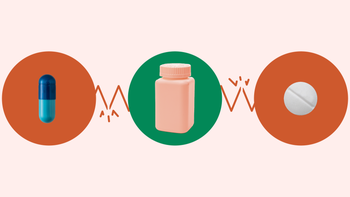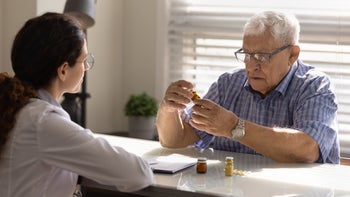
Eliquis, Xarelto, and More: What You Should Know About 8 Common Blood Thinner Medications
Key takeaways:
Anticoagulants are blood thinner medications that help prevent and treat blood clots. There are several options available, including oral pills and injections. These medications work differently than antiplatelet blood thinners, such as Plavix (clopidogrel).
Warfarin is an oral blood thinner medication that requires frequent monitoring. Eliquis (apixaban) and Xarelto (rivaroxaban) are examples of newer alternatives.
There are many ways to save on common blood thinner medications. Many options have manufacturer savings cards to help make your prescription more affordable. GoodRx can help you navigate your options.
Table of contents

Eliquis. Xarelto. Pradaxa. These blood thinners belong to a group of medications called direct oral anticoagulants (DOACs). But DOACs weren’t always an option. Before their FDA approvals, people mostly relied on warfarin (Coumadin, Jantoven) to prevent and treat blood clots.
Today, there are many blood thinner medication options to choose from. Most fall into two main categories: antiplatelets and anticoagulants. The right blood thinner for you depends on several factors, including medical history and preferences. The reason you’re taking one can also determine your options.
Here, we’ll discuss eight common anticoagulant blood thinners and ways you might be able to save on them.
1. Warfarin
Warfarin is an oral blood thinner that has been around for decades. It works by blocking an enzyme (protein) needed to activate vitamin K. Some blood clotting factors (proteins) need vitamin K in order to form clots. So blocking its formation helps prevent certain types of blood clots from forming.
Warfarin is approved to prevent and treat blood clots in both adults and children. You’ll typically take it once daily. And your warfarin dosage will be unique to you.
Warfarin has a narrow therapeutic index. This means that small changes in your blood levels can have a big impact. Because of this, it requires frequent blood tests to ensure your dosage is safe and effective. What’s more, it can interact with many medications and foods.
Is warfarin available as a generic?
Yes. Warfarin is available as a generic medication. You might be familiar with warfarin by its brand name, Coumadin. But that product was discontinued in 2020.
Jantoven is a branded generic version of warfarin. This means it’s an approved generic form of warfarin that’s sold under a brand name.
How to save on warfarin
GoodRx can help you save over 80% off the average retail price of the generic warfarin. Generic warfarin’s price at certain pharmacies is as low as $4.00 with a free GoodRx discount.
Read more like this
Explore these related articles, suggested for readers like you.
2. Eliquis
Eliquis (apixaban) is a DOAC that’s approved for adults only. It’s typically taken twice daily. DOACs work by blocking specific proteins at various steps along the blood clotting process. Eliquis works by stopping a clotting factor called factor Xa. It helps prevent and treat blood clots in different situations (like after surgery).
Unlike warfarin, DOACs like Eliquis don’t require frequent monitoring. They also don’t have as many interactions. If you’re currently taking warfarin and want to take Eliquis instead, it’s possible to make the switch. Your healthcare provider can determine if it’s an option for you.
Is Eliquis available as a generic?
The first Eliquis generics were approved in 2019. But they won’t be on the market until at least 2026.
How to save on Eliquis
There are many ways to save on your Eliquis prescription. If you have commercial insurance, you could pay as little as $10 per fill with a savings card from the manufacturer. A free trial offer is also available.
If you’re uninsured or underinsured, you may be eligible to receive Eliquis at no cost through a patient assistance program.
3. Xarelto
Xarelto (rivaroxaban) is another DOAC that works by stopping factor Xa. It’s used to treat and prevent blood clots in different situations in adults and children. Adults typically take Xarelto once daily. Children typically take it 1 to 3 times a day.
It’s also possible to make the switch from warfarin to Xarelto if your provider approves it.
There are several similarities between Xarelto and Eliquis, including how they work and possible side effects. Generally speaking, there’s no “best” DOAC. You may prefer Xarelto’s once-daily dosing. But Eliquis may be a good option if you have kidney problems.
Is Xarelto available as a generic?
The FDA has tentatively approved a few Xarelto generics. But they may not be available until 2024.
How to save on Xarelto
If you have commercial insurance, you could pay as little as $10 for your Xarelto prescription with a savings card from the manufacturer. A patient assistance program is also available.
4. Pradaxa
Pradaxa (dabigatran) is a DOAC that works by blocking a clotting factor called thrombin. The oral capsules are approved to treat and prevent blood clots in adults and children. It’s also available as oral pellets that can be mixed into certain foods or beverages for children. Pradaxa is typically taken once or twice a day.
Unlike Xarelto and Eliquis, Pradaxa doesn’t contain lactose. If you have a severe lactose allergy, your healthcare provider may recommend Pradaxa as an option.
Is Pradaxa available as a generic?
Yes. But only two Pradaxa doses are available as generics: 75 mg and 150 mg capsules. The 110 mg capsule is still only available as a brand-name product.
How to save on Pradaxa
GoodRx can help you save over 80% off the average retail price of the generic version. Generic Pradaxa’s price is as low as $66.18 at certain pharmacies with a free GoodRx discount.
If you have commercial insurance, you could pay as little as $0 for your brand-name Pradaxa prescription with a savings card from the manufacturer.
5. Savaysa
Savaysa (edoxaban) is a DOAC that works by blocking factor Xa. It’s approved to lower the risk of blood clots and stroke in adults with a certain type of abnormal heart rhythm. It’s also used to treat blood clots in the legs or lungs. Savaysa is typically taken once daily.
Depending on your kidney function, Savaysa may not be an option for you. If your kidneys clear Savaysa too fast, it may not work as well. The opposite can happen if you have kidney problems. Your healthcare provider will check your kidneys before starting treatment to be sure.
Is Savaysa available as a generic?
No. Savaysa is only available as a brand-name product. Generics may not be available until 2028.
How to save on Savaysa
If you have commercial insurance, you could pay as little as $4 for your Savaysa prescription with a savings card from the manufacturer.
6. Arixtra
Arixtra (fondaparinux) is an injectable blood thinner that works by activating a protein that stops factor Xa from working. It’s approved to prevent blood clots in adults undergoing hip, knee, or abdominal surgery. It’s also used in combination with warfarin to treat blood clots in the legs or lungs.
Arixtra is injected once daily. It’s not used for long-term reasons, like blood clot prevention in people with abnormal heart rhythms. So, you’ll typically only use it for a short amount of time.
Is Arixtra available as a generic?
Yes. Generics versions of Arixtra are available.
How to save on Arixtra
There are many ways to save with Arixtra. GoodRx can help you save over 60% off the average retail price of the generic version. If you’re eligible, patient assistance programs are available that provide the brand-name medication free of charge.
7. Lovenox
Lovenox (enoxaparin) is another injectable blood thinner that’s approved for adults. It belongs to a class of medications known as low-molecular-weight heparin (LMWH). Lovenox prevents blood clots by activating a protein that blocks factor Xa. It’s typically injected once or twice a day.
Lovenox is approved to prevent blood clots after different types of surgery and in high-risk people who are sick with limited mobility. It’s also used to treat blood clots in combination with warfarin. And you may be given Lovenox during and after a heart attack.
Is Lovenox available as a generic?
Yes. Generic versions of Lovenox are available.
How to save on Lovenox
GoodRx can help you save over 90% off the average retail price of generic Lovenox. Generic Lovenox’s price at certain pharmacies is as low as $86.38 with a free GoodRx discount.
A patient assistance program is also available for brand-name Lovenox if you’re uninsured or underinsured.
8. Fragmin
Fragmin (dalteparin) is also an injectable LMWH. Depending on why you’re using it, Fragmin is typically injected once or twice a day.
Like Lovenox, Fragmin is approved to prevent blood clots in certain situations and after a heart attack. But it’s also used to treat and lower the risk of blood clots in children and people with cancer.
Is Fragmin available as a generic?
No. Fragmin is only available as a brand-name product.
How to save on Fragmin
GoodRx can help you save over 15% off the average retail price of Fragmin. Your healthcare provider or pharmacist can help you navigate other ways to save on your prescription.
What’s the difference between blood thinner, anticoagulant, and antiplatelet medications?
The medications in this list are all considered anticoagulant medications. They all prevent the formation of blood clots by interfering with the clotting factors that cause them. Antiplatelet medications work a bit differently. They prevent blood cells called platelets from sticking together to form clots.
Antiplatelet medications are used in different situations than most anticoagulants. They’re prescribed most often if you’ve had a heart attack or stroke or are at high risk for one. Examples of antiplatelet medications include:
Anticoagulants and antiplatelets are often collectively referred to as “blood thinners.” That’s because they all work to prevent blood clots. But the different types of blood thinners aren’t interchangeable. So most healthcare providers refer to them by their specific class to avoid confusion.
Which blood thinner medication is right (and safest) for you?
The right blood thinner medication for you depends on a few different factors. For example, some blood thinners are only used in certain situations — like blood clot prevention after surgery. Why you need to take a blood thinner can determine your options.
Your preferences can also be a factor. For example, warfarin requires frequent monitoring. And you’ll need to pay close attention to your diet during treatment, too. In this case, DOACs like Eliquis or Xarelto may be a better fit for your lifestyle. But most aren’t available as lower-cost generics yet.
Health conditions should also be considered in the decision. For example, certain blood thinners may not be preferred or safe to use in specific situations (e.g., kidney disease, pregnancy). Your healthcare provider will work with you to determine the best option for you.
Finally, safety is often top of mind when choosing the right blood thinner. Some medications, such as DOACs, may be safer than others for certain health conditions. Your provider can review the safety of your treatment options to help you choose the right blood thinner for your needs.
The bottom line
There are many blood thinner medications available to prevent and treat blood clots. Warfarin (Coumadin, Jantoven) is an anticoagulant that’s been around for a long time. Examples of newer oral anticoagulant options include Eliquis (apixaban), Xarelto (rivaroxaban), and Pradaxa (dabigatran). In some cases, injections like Arixtra (fondaparinux) or Lovenox (enoxaparin) may be recommended. In others, an antiplatelet medication, such as Plavix (clopidogrel), may be preferred. Your healthcare provider can discuss your options with you.
Why trust our experts?


References
Barnes, G. D. (2016). Anticoagulation during pregnancy: Evolving strategies. American College of Cardiology.
Boehringer Ingelheim Pharmaceuticals, Inc. (2023). Pradaxa - dabigatran etexilate pellet [package insert]. DailyMed.
Bryant Ranch Prepack. (2022). Warfarin sodium tablet [package insert].
Camber Pharmaceuticals, Inc. (2022). Camber Pharmaceuticals launches generic Pradaxa.
Dr. Reddy’s Laboratories Limited. (2021). Fondaparinux sodium injection [package insert].
Drug patent Watch. (2024). Savaysa drug patent profile.
Garcia-Sanchez, R. (2020). Discontinuation of sale and distribution of Coumadin (warfarin sodium) tablets, for oral use. Bristol Meyers Squibb.
Latwal, B., et al. (2020). Authorized generics vs. branded generics: A perspective. Journal of Generic Medicines.
North American Thrombosis Forum. (2021). Anticoagulant comparison chart.
Pfizer Laboratories Division, Pfizer Inc. (2023). Fragmin - dalteparin sodium injection [package insert]. DailyMed.
Solari, F., et al. (2023). Low-molecular-weight heparin (LMWH). StatPearls.
Stanton, B. E., et al. (2017). Comparison of the safety and effectiveness of apixaban versus warfarin in patients with severe renal impairment. Pharmacotherapy.
U.S. Food and Drug Administration. (2017). FY2015 Regulatory Science Research Report: Narrow therapeutic index drugs.
U.S. Food and Drug Administration. (2018). ANDA tentative approval.





























